
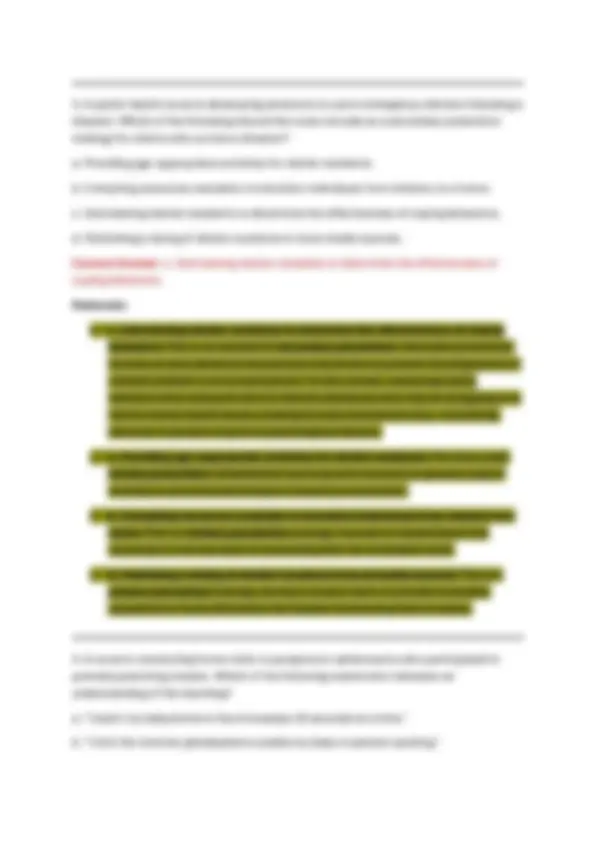
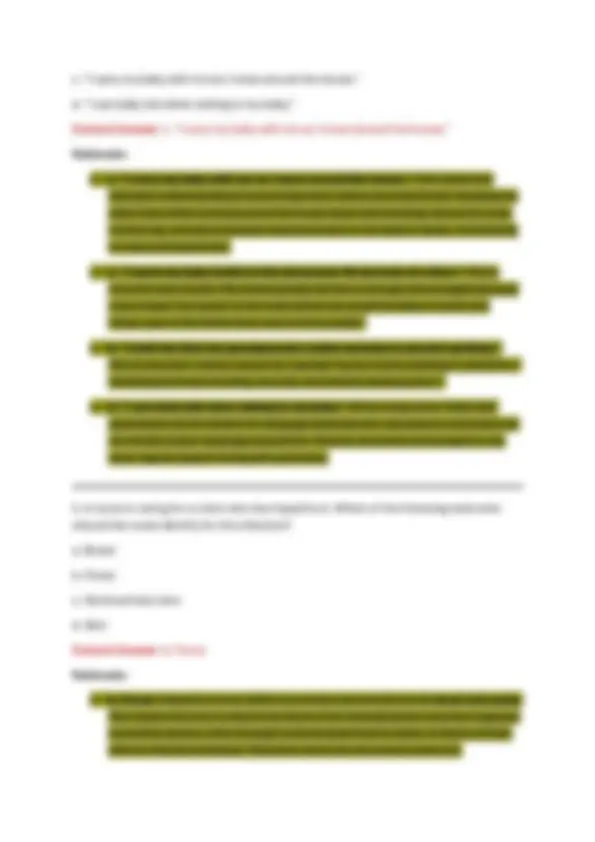
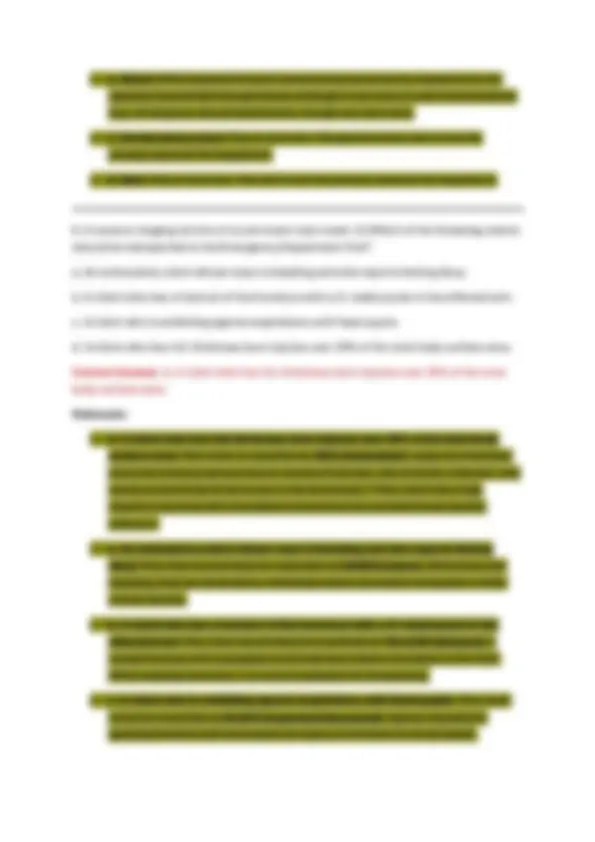
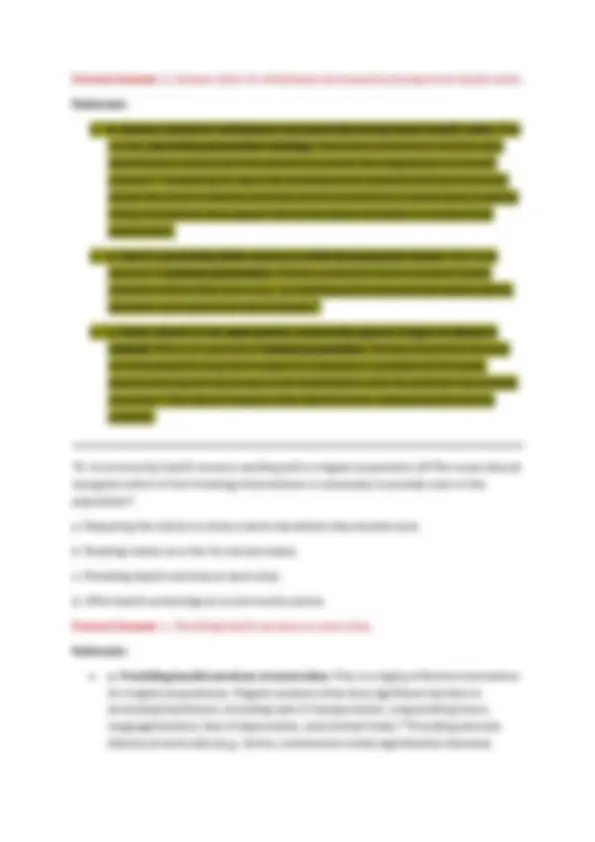
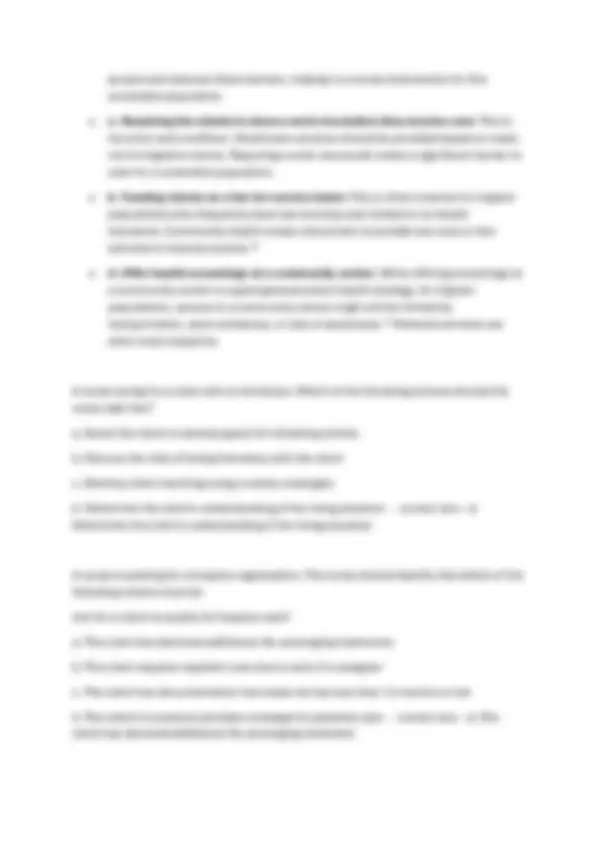
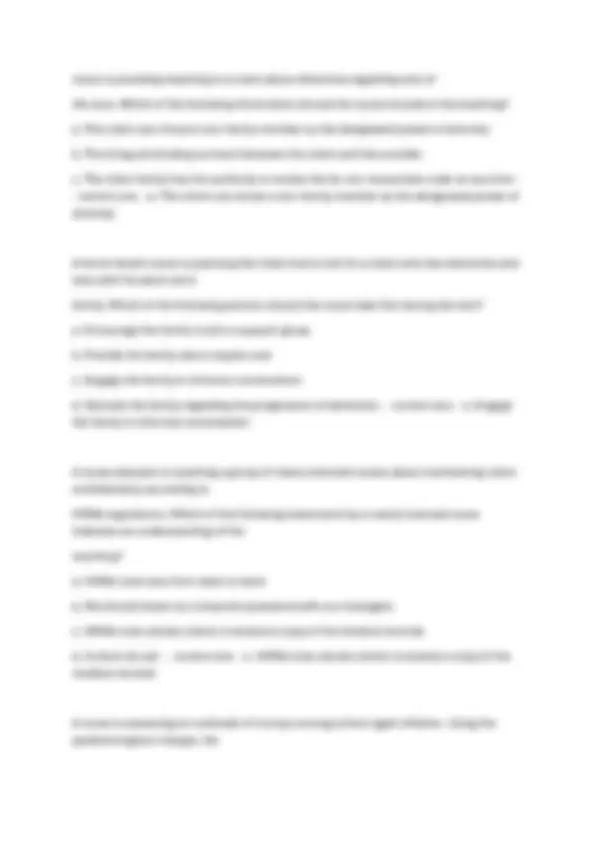
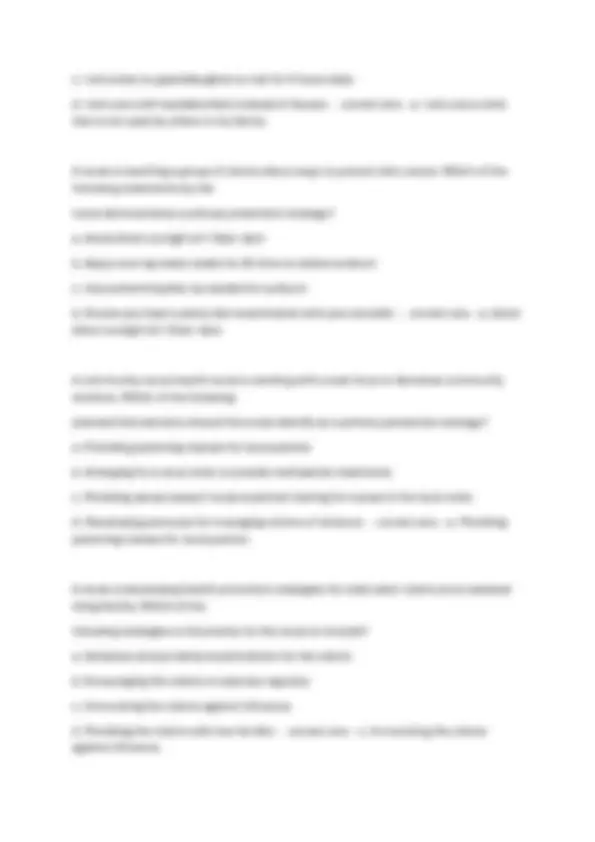
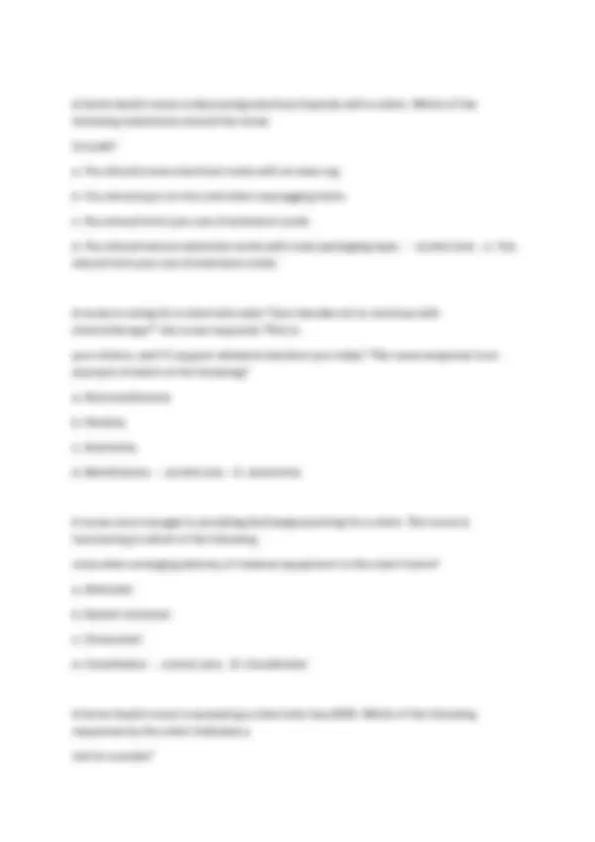
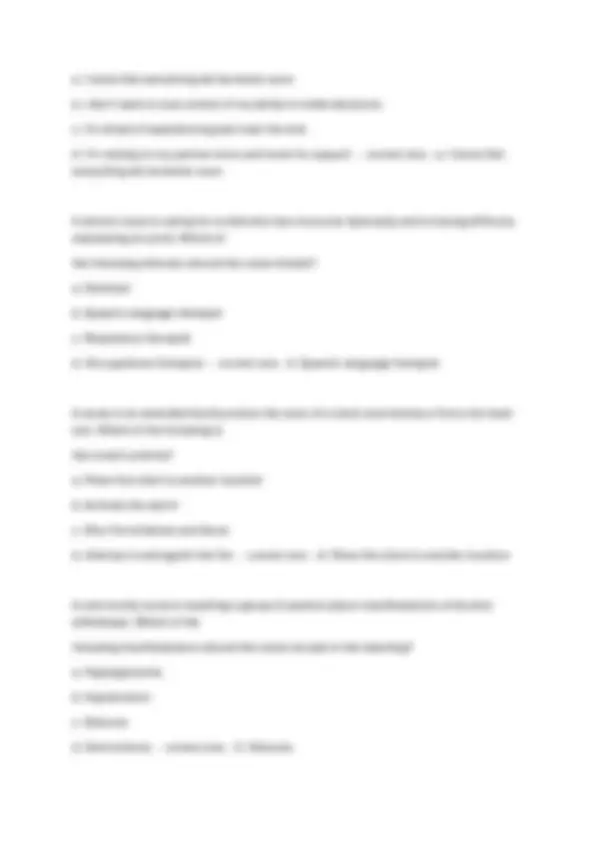
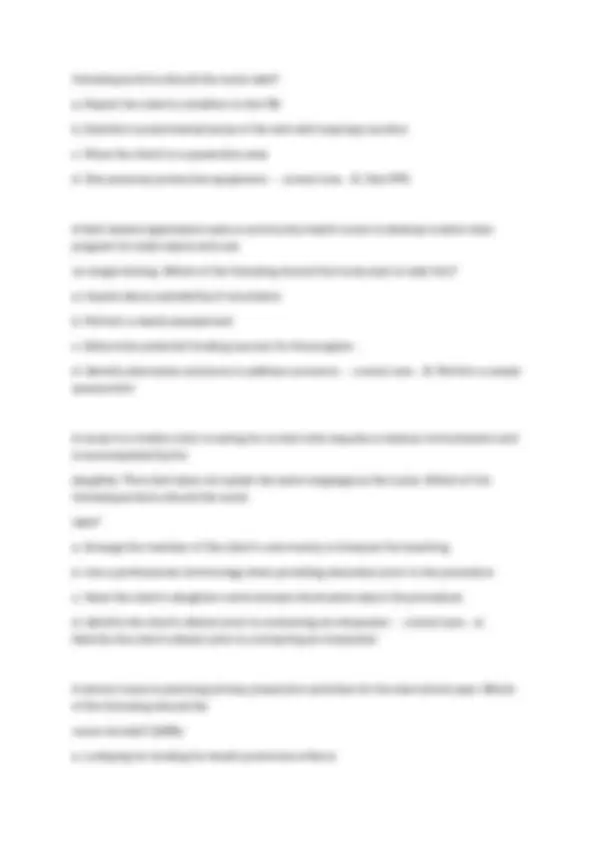
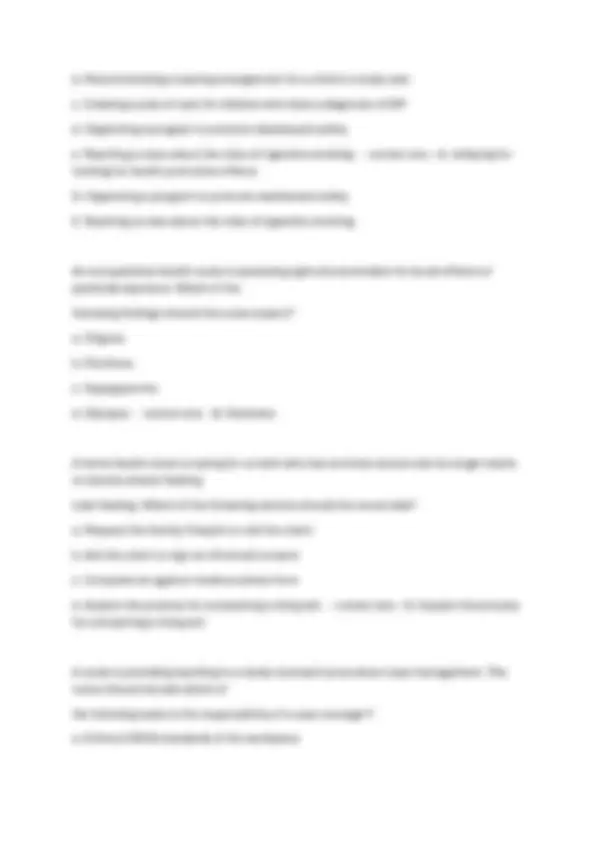
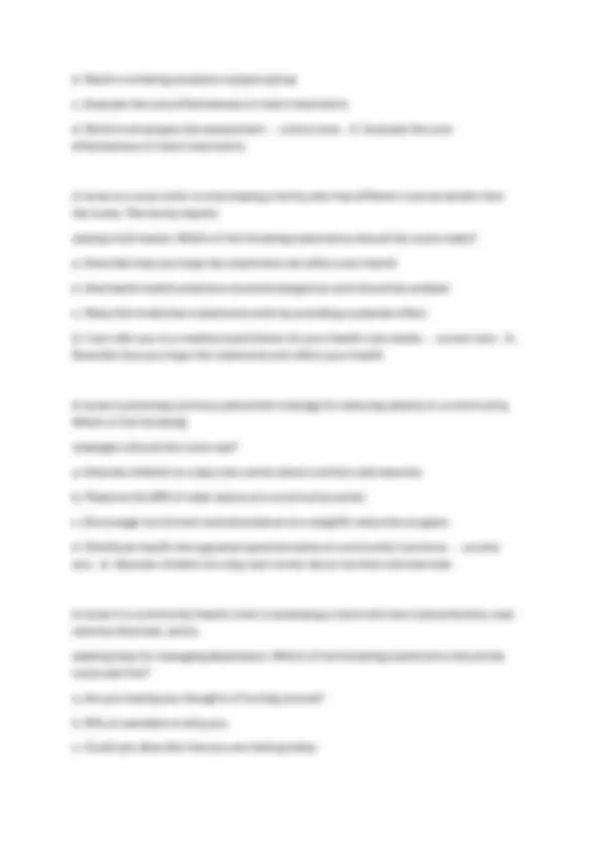
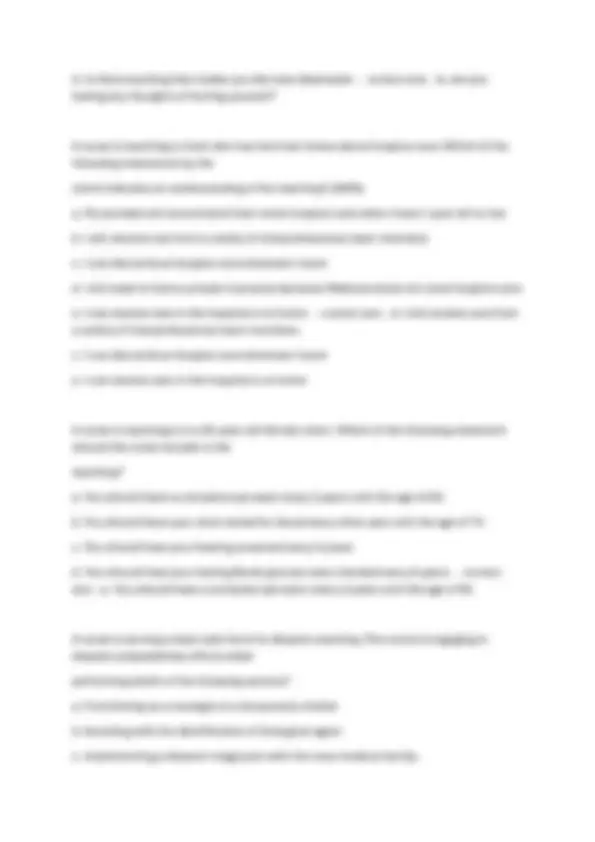
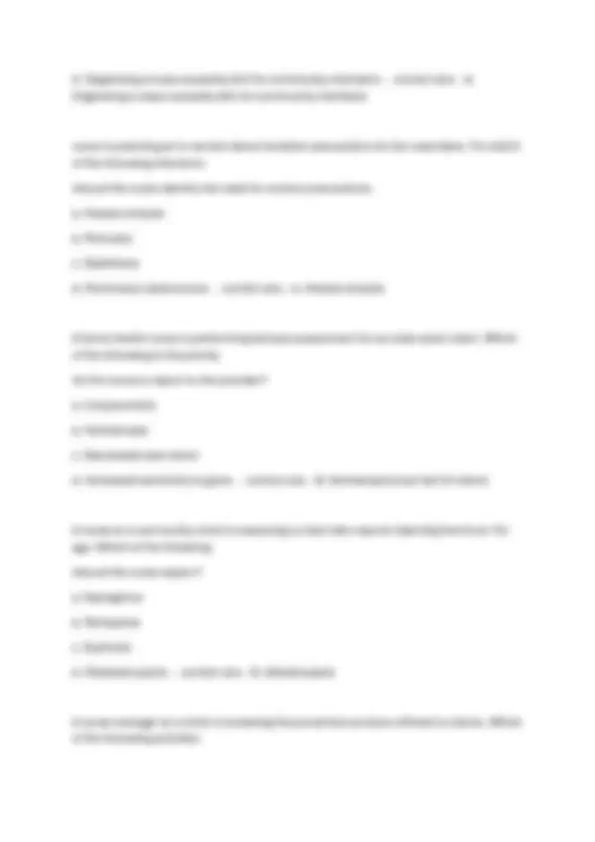
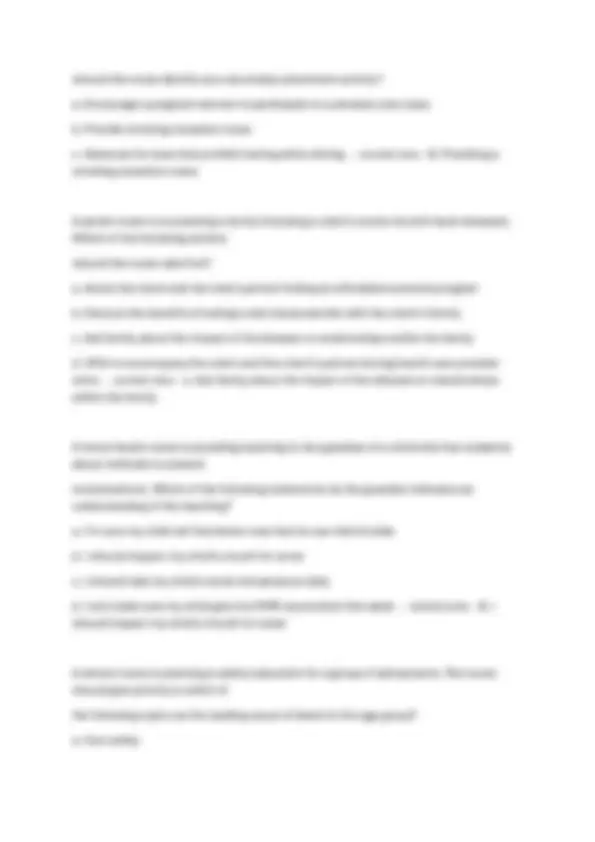
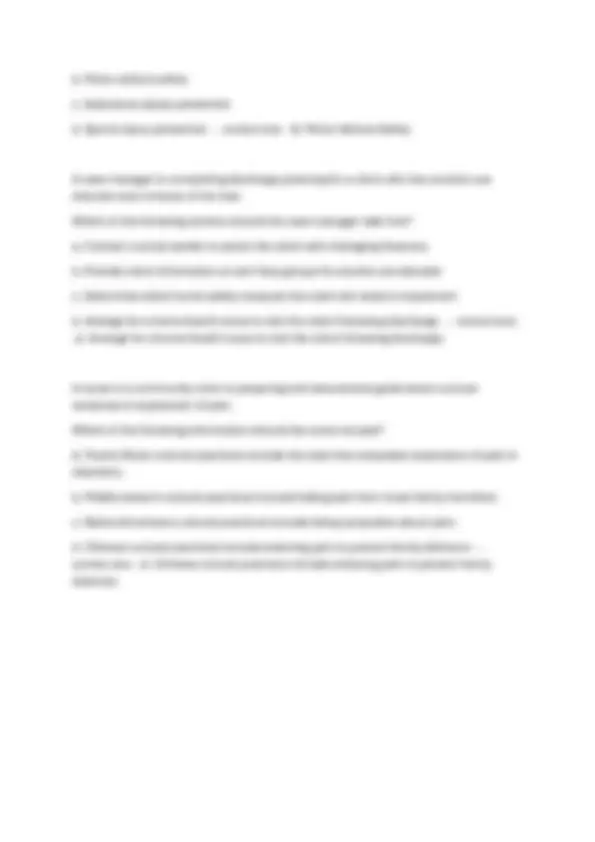


Study with the several resources on Docsity

Earn points by helping other students or get them with a premium plan


Prepare for your exams
Study with the several resources on Docsity

Earn points to download
Earn points by helping other students or get them with a premium plan
Community
Ask the community for help and clear up your study doubts
Discover the best universities in your country according to Docsity users
Free resources
Download our free guides on studying techniques, anxiety management strategies, and thesis advice from Docsity tutors
A.T.I Community Health Proctored Exam 2025 – Complete Study Guide with Practice Questions, Answers, and Expert Review for Guaranteed Success
Typology: Exams
1 / 24

This page cannot be seen from the preview
Don't miss anything!

















Here are the multiple-choice questions with rationales and indicated correct answers for the provided list.
c. "I carry my baby with me as I move around the house." d. "I use baby talk when talking to my baby." Correct Answer: c. "I carry my baby with me as I move around the house." Rationale:
c. A worker who is 7 weeks postoperative following a rotator cuff surgery and is labeling boxes. d. A worker who is wearing a back brace and bends at the waist when picking up a pallet. Correct Answer: d. A worker who is wearing a back brace and bends at the waist when picking up a pallet. Rationale:
Correct Answer: b. Assess client for withdrawal and passivity during home health visits. Rationale:
nurse is providing teaching to a client about directives regarding end-of life care. Which of the following information should the nurse include in the teaching? a. The client can chose a non-family member as the designated power of attorney b. The living will binding contract between the client and the provider c. The client family has the authority to revoke the do-not-resuscitate order at any time -
nurse should recognize that which of the following is the host? a. The vaccine b. The school c. The virus d. The children - - correct ans- - D. the children A home health nurse is caring for a client who has chemotherapy-induced nausea that has been resistant to relief from pharmacological measures. Which of the following interventions should the nurse initiate? (SATA) a. Offer 120ml(4oz) of cold 2% milk as a meal replacement b. Maintain the head of the bed in an elevated position after eating c. Provide sips of room-temperature ginger ale between meals d. Use seasoning to enhance the flavor of foods e. Assist the client in using guided imagery - - correct ans- - B. Maintain the head of the bed in an elevated position after eating C. Provide sips of room-temp ginger ale between meals E. Assist the client in using guided imagery A nurse is working with community health care team to devise strategies for preventing violence in the community. Which of the following interventions is an example of tertiary prevention? a. Urging community leaders to make nonviolence a priority b. Developing resources for victims of abuse c. Assessing for risk factors of IPV during health examinations d. Presenting community education programs about stress managemen - - correct ans-
c. I will allow my granddaughter to visit for 4 hours daily d. I will use cloth handkerchiefs instead of tissues - - correct ans- - a. I will use a toilet that is not used by others in my family A nurse is teaching a group of clients about ways to prevent skin cancer. Which of the following statements by the nurse demonstrates a primary prevention strategy? a. Avoid direct sunlight b/t 10am-4pm b. Apply cool tap water soaks for 20 mins to relieve sunburn c. Use acetaminophen as needed for sunburn d. Ensure you have a yearly skin examination with your provider - - correct ans- - a. Avoid direct sunlight b/t 10am-4pm A community nurse health nurse is working with a task force to decrease community violence. Which of the following planned interventions should the nurse identify as a primary prevention strategy? a. Providing parenting classes for local parents b. Arranging for a local clinic to provide methadone treatments c. Providing sexual assault nurse examiner training for nurses in the local clinic d. Developing protocols for managing victims of violence - - correct ans- - a. Providing parenting classes for local parents A nurse is developing health promotion strategies for older adult clients at an assisted living facility. Which of the following strategies is the priority for the nurse to include? a. Schedule annual dental examinations for the clients b. Encouraging the clients to exercise regularly c. Immunizing the clients against influenza d. Providing the clients with low-fat diet - - correct ans- - c. Immunizing the clients against influenza
A home health nurse is discussing electrical hazards with a client. Which of the following statements should the nurse include? a. You should cover electrical cords with an area rug b. You should pull on the cord when unplugging items c. You should limit your use of extension cords d. You should secure extension cords with clear packaging tape. - - correct ans- - c. You should limit your use of extension cords A nurse is caring for a client who asks "Can I decide not to continue with chemotherapy?" the nurse responds "This is your choice, and I'll support whatever decision you make." The nurse response is an example of which of the following? a. Nonmaleficence b. Veracity c. Autonomy d. Beneficence - - correct ans- - C. autonomy A nurse care manager is providing discharge planning for a client. The nurse is functioning in which of the following roles when arranging delivery of medical equipment to the client home? a. Advocate b. System allocator c. Consultant d. Coordinator - - correct ans- - D. Coordinator A home health nurse is assessing a client who has AIDS. Which of the following responses by the client indicates a risk for suicide?
A nurse is reviewing levels of prevention with a newly licensed nurse. Which of the following is an example of tertiary prevention? a. Promoting the use of helmets with children who ride bikes b. Providing STI testing for students on a college campus c. Teaching about inhaler use in a client who has asthma d. Educating adults about breast cancer screening guidelines - - correct ans- - C. Teaching about inhaler use in a client who has asthma A nurse is participating in a quality improvement committee for home health clients. Which of the following topics should the nurse recommend for the committee to review? a. An increase in levels of local air pollution b. An increase in client falls at home c. An increase in clients receiving annual flu vaccines d. An increase in client admission for home health care - - correct ans- - B. An increase in client falls at home A first response team is working at the location of a bombing incident. A nurse triaging a group of clients should give treatment priority to which of the following clients? a. Client who has a finger fracture with a 2+ pedal pulse b. A client who has superficial partial thickness burns injuries over 5% of his body c. A client who is ambulatory in exhibits manic behavior d. A client who has rigid abdomen with manifestations of shock - - correct ans- - D. A client who has a rigid abdomen with manifestations of shock A mental health nurse is scheduling a home health appointment with a client who has recently lost his partner to a
motor vehicle crash. Which of the following statements by the client indicates a need for immediate nursing intervention? a. I just feel so angry right now b. Everything is going to be fine soon c. There's no need for anyone to come see me, including you d. I'm not going to talk to you about my problems - - correct ans- - B. Everything is going to be fine soon A school nurse is planning primary prevention activities for the school year. Which of the following should the nurse plan to take? a. Monitor the immunization status of students b. Provide referrals for students who have asthma c. Provide first aid for injured students d. Schedule hearing screening for each grade leve - - correct ans- - A. monitor the immunization status of students A case manager in a rehabilitation facility is discussing discharge plans with a client who has a pressure injury and requires special beds at home. Which of the following statements should the nurse make first? a. A social worker can help you with the cost of supplies b. Describe the place where you are currently living c. Apply moisture barrier ointment 3 times a day d. Eat a balanced diet with high protein snack - - correct ans- - B. Describe the place where you are currently living A community health nurse encounters a client who has suspected bioterrorism- related illness. Which of the
b. Recommending a seating arrangement for a child in a body cast c. Creating a plan of care for children who have a diagnosis of DM d. Organizing a program to promote skateboard safety e. Teaching a class about the risks of cigarette smoking - - correct ans- - A. lobbying for funding for health promotion effects D. Organizing a program to promote skateboard safety E. Teaching a class about the risks of cigarette smoking An occupational health nurse is assessing agricultural workers for acute effects of pesticide exposure. Which of the following findings should the nurse expect? a. Oliguria b. Dizziness c. Hypoglycemia d. Diplopia - - correct ans- - B. Dizziness A home health nurse is caring for a client who has terminal cancer and no longer wants to receive enteral feeding tube feeding. Which of the following actions should the nurse take? a. Request the facility Chaplin to visit the client b. Ask the client to sign an informed consent c. Complete an against medical advice form d. Explain the process for completing a living will - - correct ans- - D. Explain the process for completing a living will A nurse is providing teaching to a newly licensed nurse about case management. The nurse should include which of the following tasks is the responsibility of a case manager? a. Enforce OSHA standards in the workplace
b. Teach a smoking cessation support group c. Evaluate the cost effectiveness of client treatments d. Perform employee risk assessment - - correct ans- - C. Evaluate the cost effectiveness of client treatments A nurse at a rural clinic is interviewing a family who has different cultural beliefs than the nurse. The family reports seeing a folk healer. Which of the following statements should the nurse make? a. Describe how you hope the treatments will affect your health b. Alternative health practices could be dangerous and should be avoided c. Many folk medicines treatments work by providing a placebo effect d. I can refer you to a medical practitioner for your health care needs - - correct ans- - A. Describe how you hope the treatments will affect your health A nurse is planning a primary prevention strategy for reducing obesity in a community. Which of the following strategies should the nurse use? a. Educate children at a day care center about nutrition and exercise b. Measure the BMI of older adults at a community center c. Encourager enrollment and attendance at a weight0-reduction program d. Distribute health risk appraisal questionnaires at community functions - - correct ans- - A. Educate children at a day care center about nutrition and exercise A nurse in a community health clinic is assessing a client who has 2 preschoolers, was recently divorced, and is seeking help for managing depression. Which of the following statements should the nurse ask first? a. Are you having any thoughts of hurting yourself b. Who is available to help you c. Could you describe how you are feeling today